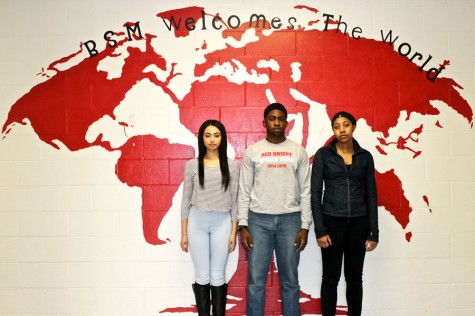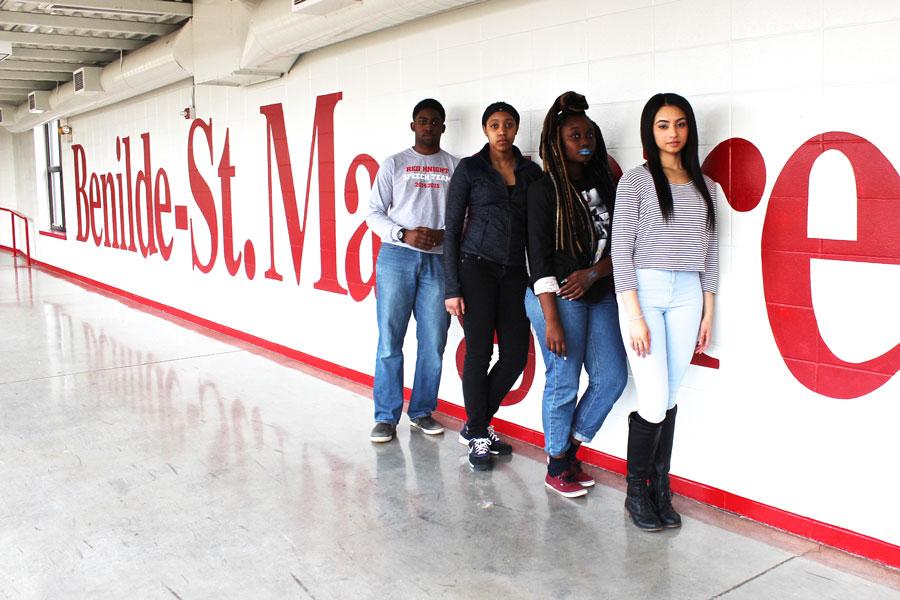Black at BSM: A KE Followup
Four years ago, the Knight Errant published an article in the April 2012 print edition titled “Black at BSM,” examining the life of BSM’s black students. The students interviewed as freshman for the article are now seniors, and many of them, who also passed through the BSM Junior High, have amassed a variety of experiences and opinions not often heard by the school community as a whole. This article looks at the past four years for these students—the challenges, the victories, and the future—shedding light on what it’s really like to be Black at BSM.
April 13, 2015
The core of the Black experience at BSM is learning to operate in a majority white environment. For senior Zeph Kaffey, this brings some tension and frustration. “I wish people knew what it felt like––I want people to know how hard it is every morning to get dressed and come here, knowing that I’m going to get stared at, judged, and looked down upon,” Kaffey said.
BSM senior Malik Nolen’s experience as a young black man has been an incredibly complex experience at a majority white school. “I felt like I had this expectation of being a black football player,” senior Malik Nolen said. “It kind of transformed me into someone that I didn’t feel proud of, and it took me a while to get back to that because I felt so different in the climate––it wasn’t something I was used to.”
Kaffey experiences negative assumptions and stereotypes related to her skin on a daily basis. “I’m looked at differently because of my color––people assume things, like I’m not smart––other people who do look like me agree with me on that,” Kaffey said. “I wish that I didn’t have to do so much work to get nowhere––I’m still looked down upon.”
One of the reasons why there are differences between black and white students’ experiences, according to Kaffey, is the lense the respective students are viewing situations through––something shaped by one’s background and life experiences. “When you come from a different background, you see things differently than everyone else,” Kaffey said. “If my dad gets pulled over, it’s not a quick thing; it’s like a 15 minute thing: [the police] trying to pull everything, trying to see what’s wrong.”
Inequalities in privilege lead to societal and systemic problems. “When I’m talking about privilege, I’m not talking about how much money you have, I’m talking about what you look like, and that’s unfair, because you can’t control that,” Kaffey said.
Senior Carly Linder shares a frustration with the privilege deeply ingrained in society and systems. “It’s hard because our country is set up for white people, and some kids don’t see that or understand that,” Linder said.
One of the most obvious distinctions about being black at BSM is the small number of black students in every classroom. “There’s, at most, three other black people in my classes,” Kaffey said.
This small number has direct consequences for the classroom dynamic. “One day we were talking about Ferguson, and when you are a kid of color and those topics come up you feel the tension in the room, and you feel isolated, and you look around and most of the kids are white,” Linder said.
However, for many students of color the problem is not the low number of students of color in the classroom––although that is still an issue––but rather a lack of awareness, lack of acceptance, and lack of embracing the idea of diversity and all its beauty. “For a student body that is extremely well educated and with such a good curriculum, we lack and are ignorant in understanding other people’s cultures,” Kaffey said. “You don’t necessarily need to dump more black kids or brown faces in our student body; we just need more culture here.”

Senior Carly Linder, junior Brandon Banks, and Senior Azzairia Jackson-Sherrod share their experience about being Black at BSM.
It should be noted that there are some areas where BSM has improved since the publication of the previous article. One such example is the introduction of new classes seeking to broaden the curriculum as a whole. “I’ve learned a lot about different cultures in my Immigrant Literature class,” Kaffey said.
For others, the faculty and staff––particularly the diversity coordinator Ms. Lidibette Guzman––have been influential in shaping their experience. “Mrs. Guzman played a huge role in my first two years here: making sure that I was comfortable, always keeping track of me, telling me when my grades were getting below her expectations, always setting the bar higher for me,” Nolen said.
There is also some progress being made in increasing the number of students of color. “I’ve noticed that there are more students of color in the junior high than when I was there, so I think it’s changed for better,” senior Azzairia Jackson-Sherrod said. “In the high school it’s the same as it was before.”
Clearly there are problems in need of addressing, but one of the biggest roadblocks to a solution is a lack of understanding of just what exactly the needs are. “I’d like more diverse curriculum, staff, students, programs, and conversations,” junior Brandon Banks said.
But Kaffey also acknowledges that there needs to be many more ideas in order to make an impact and suggests a required class for all students. “I think there should be a class required for students to take that is a cultural competency class that would teach people about privilege,” Kaffey said. “I just think we could do a lot more, and we don’t have an excuse to say we can’t.”
One of the biggest changes students wish to see is a change in attitude from the student body. “I want students to be open,” Linder said, “a lot of people get really tense and they don’t feel comfortable and they don’t want to get fully into [talking about race].”
Since the publication of “Black at BSM” four years ago, BSM’s climate has changed little, if at all, for many students of color. While those interviewed for this story certainly do not demonstrate the opinion of all students of color––nor do they claim to––their perspectives shed light on the current climate, and on what makes it harder to be black at BSM.


Michael Hawkins • Apr 15, 2015 at 7:33 pm
What an interesting article, Parker.
I remember the article 4 years ago, thinking about it and hoping for the best.
This follow-up is genius.
I have always liked the articles and opinions you are responsible for, but
this one is even better than most.
All the best,
M. Hawkins